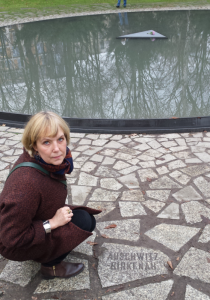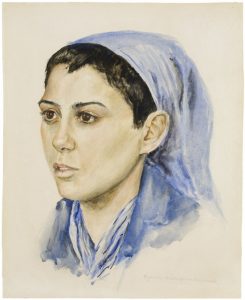HMDT Blog: A Berlin Love Song – remembering the Roma victims of Nazi persecution
This article was written for HMDT by Sarah Matthias, the author of 'A Berlin Love Song'.

This article about the inspiration for my new novel A Berlin Love Song is in memory of the 2,897 Roma men, women and children who were murdered by the Nazis on the night of 2 August 1944 in the gas chambers of Auschwitz. This date has become a symbol of remembrance for all members of the Roma community who were murdered throughout Europe between 1933 and 1945. Today, in remembering the sufferings of the Roma, we also remember all persecuted minorities of the world, in the hope that there will never be a repetition of the events that Auschwitz has come to symbolize.
It was at an exhibition in Berlin in 2011 entitled Hitler and the Germans: Nation and Crime that I first became fully aware of the extent of the Nazi persecution of the Roma. Although I had read a little about this genocide, in the context of this ‘blockbuster’ exhibition, I was forced to wonder why the extermination of so many European Roma was so little documented; relegated, at most, to a footnote in general history books about the Second World War and to an unobtrusive corner of an exhibition in Berlin. Back in London, on a visit to the permanent Holocaust exhibition in the Imperial War Museum, I found just another small corner dedicated to this genocide. Puzzled as to why these events seemed so ignored, I set about discovering all I could about the wartime victimization of the Roma. In addition to six million Jews, up to half a million Roma from all over Europe were exterminated by the Nazis, deported to concentration camps and death camps in the east, used as ‘guinea pigs’ for medical experiments, subjected to sterilization and otherwise murdered because they were regarded by the Nazis as ‘racially inferior.’
During several years of research into what has sometimes been called the ‘forgotten Holocaust,’ I read all the first-hand accounts I could find written by Roma victims of Nazi persecution who had, against all the odds, managed to escape the death camps.

Sarah Matthias at the Memorial to the Roma victims of the Nazis in Berlin’s Tiergarten Park
A Gypsy in Auschwitz by Otto Rosenberg and Winter Time by Walter Winter spring immediately to mind as powerful and moving testimonies to unimaginable suffering. I visited the long overdue memorial to the Sinti and Roma people murdered under National Socialism opened in 2012 in Berlin’s Tiergarten Park. I visited Auschwitz.
By the time I came to visit Poland I had already read everything I could get my hands on about the Zigeunerlager, the so-called ‘gypsy family camp’ in Auschwitz-Birkenau. The remains of this camp is vast, but I didn’t need a map or guide to show me round this desolate place since I had the layout so clearly in my mind. The story had lived with me for so long. And it was here, in Auschwitz, for many years a poignant symbol of Jewish persecution, that I first saw the series of paintings of Roma internees, painted by Czech Jewish artist Dina Babbitt (née Gottliebova). It was these moving paintings of Roma prisoners by a fellow Jewish prisoner that finally inspired me to write A Berlin Love Song.
Dina Gottliebova, once a talented Jewish student at the Academy of Fine Arts in Prague, was a prisoner in Auschwitz. Having witnessed the deaths of many members of her own family, she was then forced by the infamous Doctor Mengele to paint portraits of Roma internees for his book on genetic research – a work designed to prove the racial inferiority of so-called ‘non-Aryan’ races. Mengele claimed that he couldn’t get a decent photograph of the Roma with the skin tones just right, so he ordered Dina Gottliebova to paint the prisoners’ portraits instead. These paintings were Dina’s lifeline. As she says in a recorded interview many years later: “I had no choice. I painted to save my life.”
These heartbreaking portraits of Roma men women and children who died in the gas chambers of Auschwitz-Birkenau are now housed in the Auschwitz-Birkenau State Museum as evidence of the crime, and it was one of these paintings of a beautiful young Roma girl wearing a blue headscarf that inspired one of the two main characters of A Berlin Love Song. In recorded interviews, Dina Gottliebova speaks very movingly of her friendship with this young girl, herself suffering from malnutrition and whose baby had died in the camp.

Inspiration for the Character of Lili Petalo
It is remarkable, even today, how relatively few people have any detailed knowledge of the systematic persecution of the Roma. And yet today, Roma are still scapegoats, frequently victims of prejudice and racially motivated attacks, facing discrimination in every country where they live. Families often lack access to stable jobs, affordable housing, social services and health care. In A Berlin Love Song I have attempted to shine a light on the little known tragedy of the genocide of the Roma, both in order to keep the memory alive, and also in the heartfelt hope that this story will have some impact on European attitudes towards the Roma today. Holocaust Memorial Day on 27 January each year is one way people can raise awareness of Roma victims of Nazi persecution, and the prejudice they continue to face. HMDT has a range of resources available to help explore the stories of Roma victims of the Nazis and the ways in which they were persecuted. Commemoration alone is nothing if it does not also recognize our obligation to use lessons of the past to create a better future for all human beings everywhere.
A Berlin Love Song by Sarah Matthias
Max is 14, a German schoolboy, when he first meets Lili, a trapeze artist from a travelling circus that performs every year in Berlin. Lili is a Romani, and her life and customs are very different from those of Max and his family. Torn apart by the outbreak of war they meet again aged 17, when their friendship turns into love – but love between a member of the Hitler youth and a member of the Roma community is forbidden. As events wrench them apart for a second time, they wonder whether their love can survive. Set against the background of the Second World War, A Berlin Love Song is a story of passion, unexpected friendship, despair, loss, and hope.
The HMDT blog highlights topics relevant to our work in Holocaust and genocide education and commemoration. We hear from a variety of guest contributors who provide a range of personal perspectives on issues relevant to them, including those who have experienced state-sponsored persecution and genocide. The views expressed are those of the author and do not necessarily represent the views of HMDT.